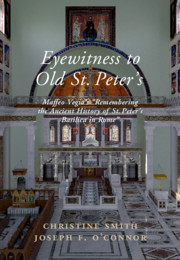 Eyewitness to Old St Peter's
Eyewitness to Old St Peter's Book contents
- Eyewitness to Old St. Peter’s
- About the Authors
- Eyewitness to Old St. Peter’s
- Copyright page
- Contents
- Figures
- Frontispiece
- Preface
- Abbreviations
- Part I The Canon and the Basilica
- Introduction
- One Maffeo Vegio
- Two The Text
- Three A Humanist Looks at a Medieval Marvel
- Four Conclusion
- Endnotes
- Part II The Text
- Part III The Image
- Bibliography
- Index
- References
One - Maffeo Vegio
Biography and Historical Context
from Part I - The Canon and the Basilica
Published online by Cambridge University Press: 03 July 2019
- Eyewitness to Old St. Peter’s
- About the Authors
- Eyewitness to Old St. Peter’s
- Copyright page
- Contents
- Figures
- Frontispiece
- Preface
- Abbreviations
- Part I The Canon and the Basilica
- Introduction
- One Maffeo Vegio
- Two The Text
- Three A Humanist Looks at a Medieval Marvel
- Four Conclusion
- Endnotes
- Part II The Text
- Part III The Image
- Bibliography
- Index
- References
Summary
Maffeo Vegio was born in 1407 in Lombardy to affluent parents, in the city of Lodi. His early education was in nearby Milan, where as a young teen he heard Bernardino of Siena preach, and whose official biography he would later write for Bernardino’s canonization in 1450.1 There he studied literature, especially poetry, and then dialectic, preparing for the career in law that his parents wished. He read law in his teens at Pavia, and by the age of 16 had composed his first hexameter poem, “Pompeiana.” He also studied Greek, achieving sufficient mastery to do some translations (“Responsio Apollinis e graeca in Latinum traducta” and “Orpheus ex graeco in latino”), which is surprising, since in our text, the “De Rebus antiquis memorabilibis basilicae S. Petri Romae” (“Remembering the Ancient History of St. Peter’s Basilica,” hereafter “Remembering St. Peter’s”), Vegio cites one of his main sources, Eusebius’s Greek Ecclesiastical History, only from Rufinus’s Latin translation of it. We don’t know whether it was during this early period that he studied Milanese Early Christian and medieval history, knowledge of and sources for which he drew on in “Remembering St. Peter’s,” or whether he acquired this information later in Rome.
- Type
- Chapter
- Information
- Eyewitness to Old St Peter'sA Study of Maffeo Vegio's ‘Remembering the Ancient History of St Peter's Basilica in Rome,' with Translation and a Digital Reconstruction of the Church, pp. 17 - 50Publisher: Cambridge University PressPrint publication year: 2019


